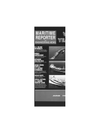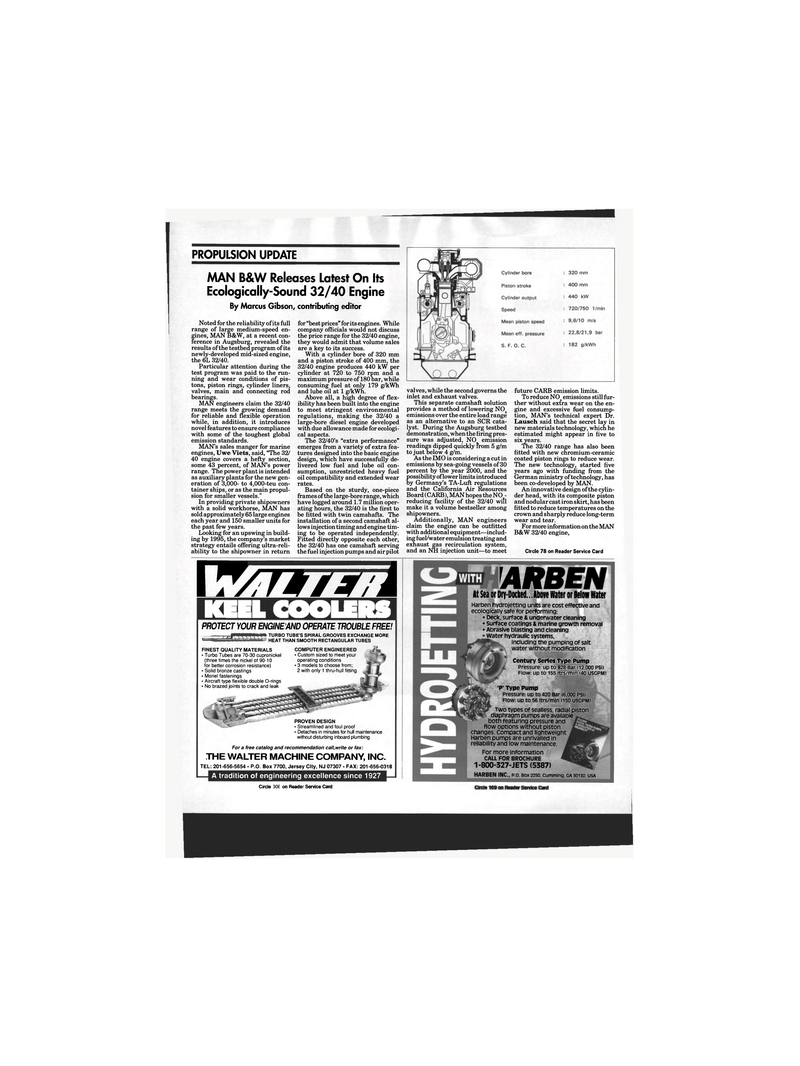
Page 9: of Maritime Reporter Magazine (June 1993)
Read this page in Pdf, Flash or Html5 edition of June 1993 Maritime Reporter Magazine
PROPULSION UPDATE
MAN B&W Releases Latest On Its
Ecologically-Sound 32/40 Engine
By Marcus Gibson, contributing editor
Noted for the reliability of its full range of large medium-speed en- gines, MAN B&W, at a recent con- ference in Augsburg, revealed the results of the testbed program of its newly-developed mid-sized engine, the 6L 32/40.
Particular attention during the test program was paid to the run- ning and wear conditions of pis- tons, piston rings, cylinder liners, valves, main and connecting rod bearings.
MAN engineers claim the 32/40 range meets the growing demand for reliable and flexible operation while, in addition, it introduces novel features to ensure compliance with some of the toughest global emission standards.
MAN's sales manger for marine engines, Uwe Viets, said, "The 32/ 40 engine covers a hefty section, some 43 percent, of MAN's power range. The power plant is intended as auxiliary plants for the new gen- eration of 3,000- to 4,000-teu con- tainer ships, or as the main propul- sion for smaller vessels."
In providing private shipowners with a solid workhorse, MAN has sold approximately 65 large engines each year and 150 smaller units for the past few years.
Looking for an upswing in build- ing by 1995, the company's market strategy entails offering ultra-reli- ability to the shipowner in return for "best prices" for its engines. While company officials would not discuss the price range for the 32/40 engine, they would admit that volume sales are a key to its success.
With a cylinder bore of 320 mm and a piston stroke of 400 mm, the 32/40 engine produces 440 kW per cylinder at 720 to 750 rpm and a maximum pressure of 180 bar, while consuming fuel at only 179 g/kWh and lube oil at 1 g/kWh.
Above all, a high degree of flex- ibility has been built into the engine to meet stringent environmental regulations, making the 32/40 a large-bore diesel engine developed with due allowance made for ecologi- cal aspects.
The 32/40's "extra performance" emerges from a variety of extra fea- tures designed into the basic engine design, which have successfully de- livered low fuel and lube oil con- sumption, unrestricted heavy fuel oil compatibility and extended wear rates.
Based on the sturdy, one-piece frames of the large-bore range, which have logged around 1.7 million oper- ating hours, the 32/40 is the first to be fitted with twin camshafts. The installation of a second camshaft al- lows injection timing and engine tim- ing to be operated independently.
Fitted directly opposite each other, the 32/40 has one camshaft serving the fuel injection pumps and air pilot valves, while the second governs the inlet and exhaust valves.
This separate camshaft solution provides a method of lowering NOx emissions over the entire load range as an alternative to an SCR cata- lyst. During the Augsburg testbed demonstration, when the firing pres- sure was adjusted, NO emission readings dipped quickly from 5 g/m to just below 4 g/m.
As the IMO is considering a cut in emissions by sea-going vessels of 30 percent by the year 2000, and the possibility of lower limits introduced by Germany's TA-Luft regulations and the California Air Resources
Board (CARB), MAN hopes the NO - reducing facility of the 32/40 will make it a volume bestseller among shipowners.
Additionally, MAN engineers claim the engine can be outfitted with additional equipment—includ- ing fuel/water emulsion treating and exhaust gas recirculation system, and an NH injection unit—to meet future CARB emission limits.
To reduce NO emissions still fur- ther without ex£ra wear on the en- gine and excessive fuel consump- tion, MAN's technical expert Dr.
Lausch said that the secret lay in new materials technology, which he estimated might appear in five to six years.
The 32/40 range has also been fitted with new chromium-ceramic coated piston rings to reduce wear.
The new technology, started five years ago with funding from the
German ministry of technology, has been co-developed by MAN.
An innovative design of the cylin- der head, with its composite piston and nodular cast iron skirt, has been fitted to reduce temperatures on the crown and sharply reduce long-term wear and tear.
For more information on the MAN
B&W 32/40 engine,
Circle 78 on Reader Service Card
VTTjwrm KEEL COOLERS
PROTECT YOUR ENGINE AND OPERATE TROUBLE FREE!
TURBO TUBE'S SPIRAL GROOVES EXCHANGE MORE
HEAT THAN SMOOTH RECTANGULAR TUBES
For a free catalog and recommendation call, write or fax:
THE WALTER MACHINE COMPANY, INC.
TEL: 201-656-5654 • P.O. Box 7700, Jersey City, NJ 07307 • FAX: 201-656-0318
A tradition of engineering excellence since 1927
Circle 162 on Reader Service Card
ARBEN At Sea or Dry-Docked...Above water or Below Water
Harben hydrojetting units are cost effective and ecologically safe for performing: • Deck, surface & underwater cleaning • Surface coatings & marine growth removal • Abrasive blasting and cleaning water hydraulic systems, including the pumping of salt water without modification
Century Series Type Pump
Pressure: up to 828 Bar <12,000 PSl> Flow: up to 155 Itrs/min (40 USGPM) 'P* Type Pump
Pressure: up to 420 Bar (6,000 PSD
Flow: up to 56 Itrs/min (150 USGPM)
Two types of sealless, radial piston diaphragm pumps are available, both featuring pressure and flow options without piston changes. Compact and lightweight, Harben pumps are unrivalled in reliability and low maintenance.
For more information CALL FOR BROCHURE 1-800-327-JETS (5387)
HARBEN INC., P.O. Box 2250, cumming, OA 30130, USA
Circle 169 on Reader Service Card
FINEST QUALITY MATERIALS • Turbo Tubes are 70-30 cupronickel (three times the nickel of 90-10 for better corrosion resistance) • Solid bronze castings • Monel fastenings • Aircraft type flexible double O-rings • No brazed joints to crack and leak
COMPUTER ENGINEERED • Custom sized to meet your operating conditions • 3 models to choose from; 2 with only 1 thru-hull fitting
PROVEN DESIGN • Streamlined and foul proof • Detaches in minutes for hull maintenance without disturbing inboard plumbing

 8
8

 10
10
